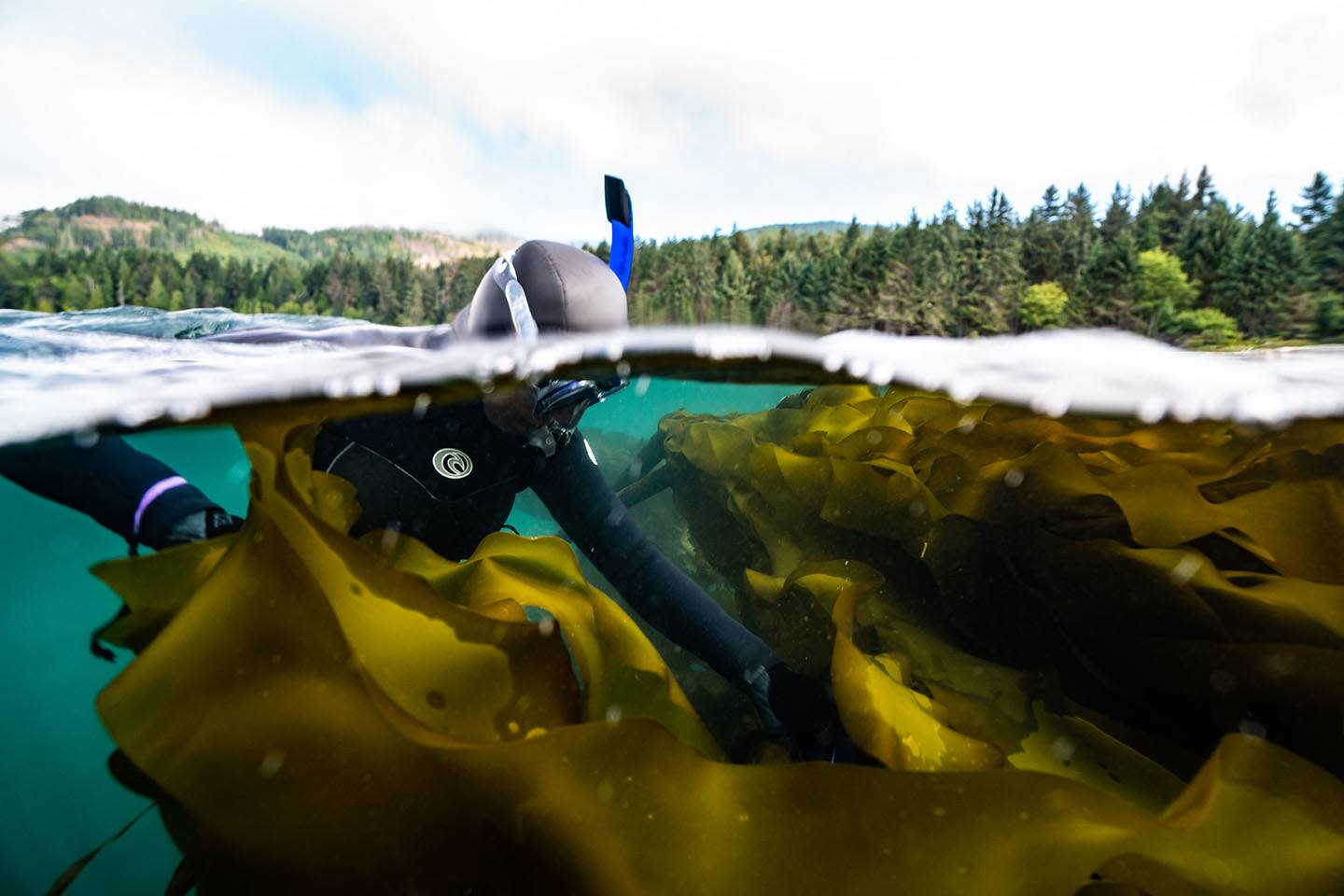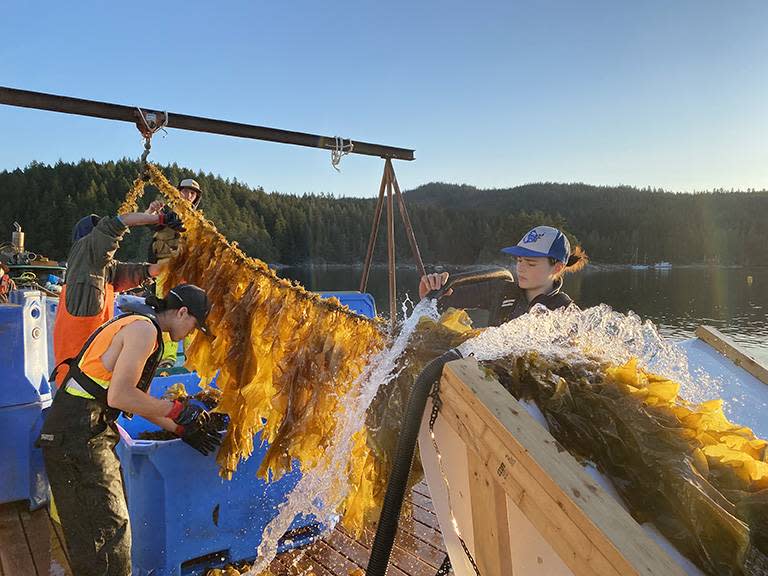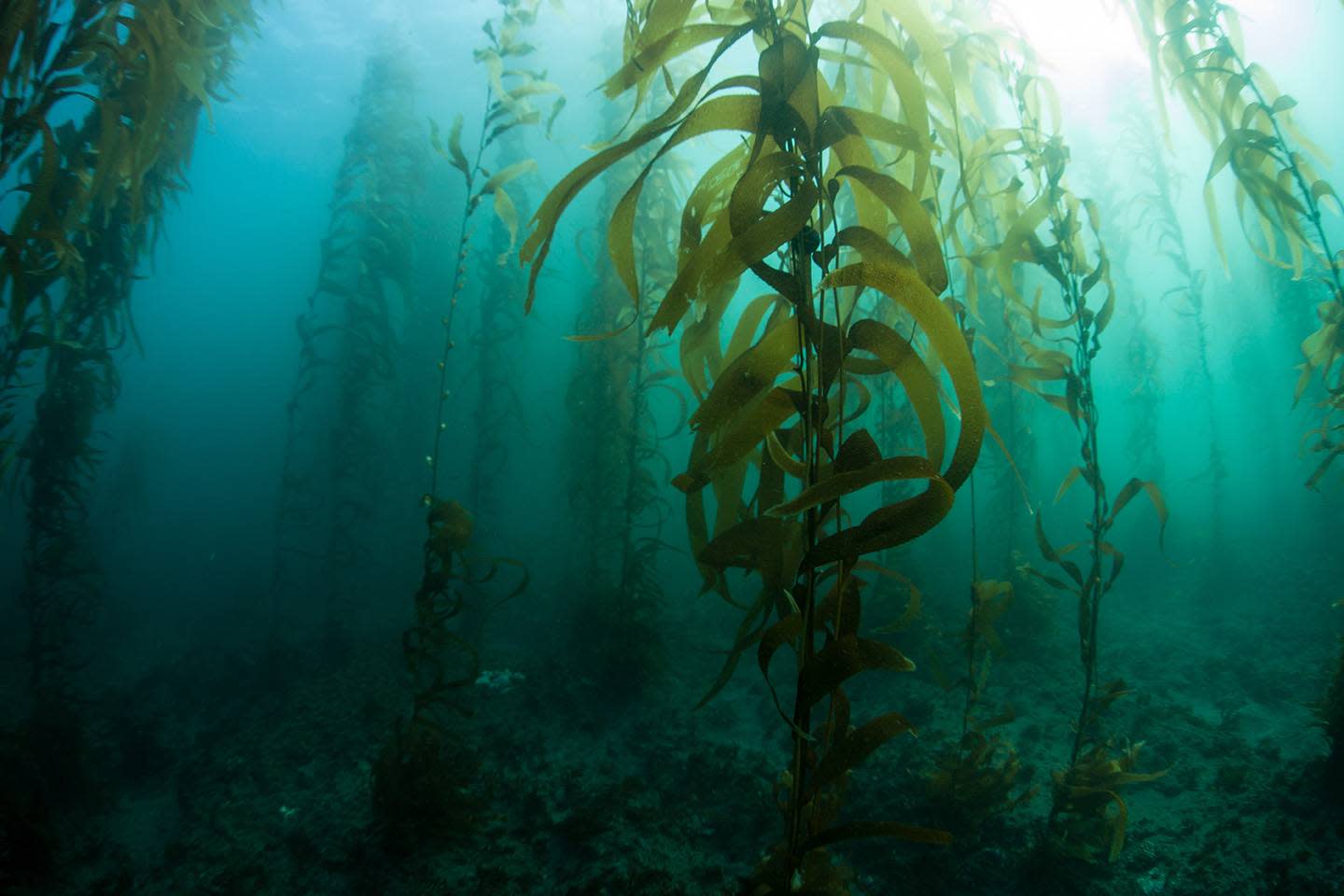Banking on Seaweed

Banking on Seaweed
Farming the “mermaid’s garden” is becoming a profitable business on Vancouver Island, both for passionate artisans and ambitious commercial operations.

It all started with Sooke’s Seaweed Lady, Diane Bernard, who founded Seaflora Skincare in 1998.
“Poor seaweed, they have such a PR problem!” Just as we wouldn’t judge gardeners by their compost piles, Bernard says, we shouldn’t judge seaweed by what washes up on shore.
“We don’t call it slimy, we call it gelatinous.”
The entire coast of Vancouver Island is extraordinary for its sheer tonnage and hundreds of varieties of seaweed. But what is seaweed, and why could it become big business?
Algae, Not Plants
Seaweed is the common name for some 10,000 species of algae that thrive in the ocean as well as in rivers and lakes. They are some of the fastest-growing organisms on Earth, capable of growing up to 30 centimetres per day. They harness the power of sunlight and nutrients in the ocean to achieve this extraordinary growth.
Seaweed species such as kelp provide essential nursery habitat for fisheries and other marine life and thus protect our seafood sources. Other species, such as planktonic algae, play a vital role in capturing carbon, and produce at least 50 per cent of the Earth’s oxygen.
Some seaweeds are microscopic. Some are enormous, like the giant kelps that grow in “forests” and tower as much as 30 metres from their roots on the seabed. Most are medium-sized and are classed in colours of green, brown and red. They are algae, not plants, without true roots or leaves; they typically grow from a holdfast on rocks and float up toward the surface.
The term “seaweed” is a misnomer, because a weed is a plant that spreads so profusely it can harm the habitat where it takes hold (consider kudzu or broom). Not only are the fixed and free-floating “weeds” of the sea essential to innumerable marine creatures, both as food and as habitat, they also benefit us land dwellers.
Many seaweeds contain anti-inflammatory and anti-microbial agents. Their medicinal effects have been recognized for thousands of years. Ancient Romans used them to treat wounds, burns and rashes. Ancient Egyptians may have used them as a cancer treatment.
Certain seaweeds do, in fact, possess powerful cancer-fighting agents that modern researchers hope will eventually prove effective in the treatment of malignant tumors and leukemia. While dietary soy was long credited for the low rate of cancer in Japan, this indicator of robust health is now attributed to seaweed.
These versatile marine plants and algae have also contributed to economic growth. Among their many uses in manufacturing, they are effective binding agents (emulsifiers) in such everyday goods as toothpaste and jelly, and popular softeners (emollients) in organic cosmetics and skin-care products.
Sea to Skin
Seaflora Skincare, the company that Bernard founded 25 years ago, makes products for the largest organ of the human body: the skin. Seaflora believes that seaweed is the unsung hero of the skin-care world, a natural powerhouse teeming with vitamins, minerals and amino acids. These elements work together to nourish, soothe and protect the skin. But how exactly does it work?
Anti-aging: Seaweed is rich in antioxidants and essential fatty acids that fight against free radicals, believed to cause premature aging. Its ability to stimulate collagen production may help to reduce the appearance of lines and wrinkles, leading to smoother, more youthful-looking skin.
Eczema: Seaweed’s natural anti-inflammatory properties can help to soothe the redness and itching associated with eczema. Its nutrient-rich composition aids in strengthening the skin barrier, keeping irritants out and moisture in.
Rosacea: Those battling rosacea may benefit from seaweed’s ability to calm inflammation and reduce redness. Its cooling effect can provide much-needed relief to heated, uncomfortable skin.
Acne: Seaweed is a science-backed solution for acne-prone skin and recommended by many dermatologists. Its antibacterial properties can help to combat acne-causing bacteria, balance oil production and prevent further breakouts.
Psoriasis: The potent antioxidants in seaweed can help alleviate the symptoms of psoriasis by reducing inflammation and accelerating the skin’s natural healing process.
Seaflora uses only wild, hand-harvested kelps, red algae and sea mud to maintain freshness and potency. The company became the world’s first U.S. Department of Agriculture-certified organic skin-care line in 2005, and has been honoured by the David Suzuki Foundation and the EcoStar Awards.
Bernard retired in 2018 and passed the torch to the second generation, her son Adam Butcher (whose summer job as a teenager was gathering seaweed) and his wife, Chantelle Line. The pandemic hobbled the business as spas and retail outlets closed, but their investment in website, online sales and social media was critical to their survival. They’re thriving once again.
Seaweed as Health Food
Not far from Seaflora, another pioneering artisanal business harvests seaweed for food products.
In 2003, marine biologist Amanda Swinimer’s deep love of the ocean brought her to Vancouver Island, where she founded Dakini Tidal Wilds. For two decades, Swinimer has been sustainably harvesting wild, edible seaweeds. She shares her passion with a diverse audience through lectures, tours and as the author of two books on seaweed. The focus of Swinimer’s teaching is sustainability and respect for the fragile coast of the Pacific Northwest. Swinimer is an engaging speaker, and has taught at public schools, post-secondary institutions and to businesses.
Dakini makes a range of edible seafood products and flavourings. Its winged kelp and bull kelp are harvested by hand and tested for purity, then dried and packaged for restaurants and direct sale. Seaweeds are among the most nutritive and complete foods, and the most concentrated source of minerals on the planet.
Kelps in particular are unique in their ability to eliminate certain heavy metals, PCBs, dioxins and radioactive compounds from the body. They do this via a compound called sodium alginate. This quality makes the kelp family one of the most important sources of protection against today’s harmful environmental toxins. Seaweed may even help you lose weight as it contains filling fibre, few calories and contributes to increased metabolism.
Just as important, seaweed tastes good. It can be added to soups to flavour the broth, cut into bite-sized pieces in stir-fries, cooked like a vegetable in pasta dishes, boiled with rice and beans or wrapped around fish and baked in the oven. Seaweed adds umami, a deep but gentle flavour with a delicate aroma. Sprinkling some dried seaweed (like Dakini’s Mermaid Shake) on food not only adds taste, texture and flavour, it’s an easy way to boost the intake of vitamins and minerals.
Not Just Sustainable, but Regenerative
Mike Williamson, CEO of Cascadia Seaweed in Sidney, is nothing if not bullish on Vancouver Island’s seaweed rush. Cascadia is already Canada’s biggest player in the seaweed business, and Williamson has his eye set on North America.
Unlike Seaflora and Dakini, Cascadia is a large commercial operation answerable to partners and investors. But that’s not to say they don’t recognize social and environmental issues. Cascadia is a certified B-Corp, meaning it meets high standards of transparency and accountability. A key to its success is working hand-in-hand with coastal Indigenous communities to the benefit of both.
Says Williamson, “We have a strong commitment to our [Indigenous] partners. Participation by coastal First Nations is critical to the long-term success of the seaweed industry in Canada due to their stewardship of the ocean.” Cascadia currently has agreements with seven First Nation communities.
Cascadia “farms” rather than wild-gathers seaweed, mostly sugar kelp. It has some 100 kilometres of line “seeded” — the largest in Canada. And its workers are careful to maintain future crops and marine habitat. Williamson scoffs when asked if Cascadia is sustainable. “We go beyond sustainable; we aim to be regenerative.” He goes on to say: “Climate change is the most pressing issue of our time.”
Cascadia’s farming process is straightforward. Sugar kelp prunings are taken from wild plants in the fall, and their spores are spread onto twine wrapped around PVC pipes in a nursery composed of tanks in adapted shipping containers.
After about a month, when the young kelps are smaller than a fingernail, they are transported to ocean farms, where the twine is rewrapped around long lines anchored a few metres below the surface. Here, they grow until early spring. By March or April, several-metre-long fronds are ready for harvest. The company leaves about 10 per cent of the seaweed behind as habitat, and to provide a source for the next year’s crop.
Their products range from bio-stimulants (fertilizers) to animal feed, but they are continually developing other products, from protein puffs to tortilla chips. Sidney brewery Small Gods even partnered with Cascadia to produce a smoked dulse stout called Sea of Tranquility.
Cascadia has ambitious plans to be the biggest commercial seaweed producer not only in Canada, but in North America. Next year they’re aiming to harvest 250 tonnes, but their lofty five-year goal is to have 1,000 hectares under cultivation, producing 35,000 tonnes. They have spent some $3.5 million on Vancouver Island to date. Globally, the market is growing exponentially, and is expected to rise from $3 billion today to $9 billion in a decade.

Food, Health, Beauty … What’s Not to Love About Seaweed?
Most people see the seaweed rush as a good-news story. The Safe Seaweed Coalition — an umbrella research and industry group founded to promote safe expansion of the industry — says humanity could, and should, be harvesting 15 times more seaweed by 2050.
The coalition estimates that seaweed — high in protein and nutrients — could add 10 per cent to the world’s food supply using just 0.03 per cent of the ocean surface. One study concluded that substituting 10 per cent of human food with seaweed by 2050 could spare 110 million hectares of land for purposes other than agriculture.
Seaweed feeds us, our crops and our animals; it promotes health and beauty; and it helps replenish the environment. So what’s the downside?
For one, there are a lot of unknowns. We know much more about every other commercial crop, like wheat or corn or soybeans. The record of aquaculture in B.C. — consider farmed salmon — is checkered at best. And growing large quantities of a single crop could raise the spectre of monoculture problems. On land, monocultures pursued for high profit margins have notoriously proven problematic. Then there’s the issue of introduced species and their propensity to get out of hand in a new ecosystem.
Another concern is that seaweed is declining globally, by some 1.6 per cent per year. But despite the effects of global warming elsewhere, B.C.’s stock is thriving, say local marine biologists from Bamfield to Vancouver. With that optimistic appraisal, B.C. seaweed farmers are literally wading cautiously but purposefully into this brave new market.

Victoria to make a splash with the 25th International Seaweed Symposium.
In May 2025, Victoria will host an impressive gathering of industry experts, academics, Indigenous peoples and students at the 25th International Seaweed Symposium.
The symposium is a triennial event organized by the International Seaweed Association. Dr. Kate Moran, president and CEO of Oceans Networks Canada at the University of Victoria, is co-leading the organizing committee. Representatives from Cascadia Seaweed, the Pacific Seaweed Industry Association and organizers Venue West round out the committee, which is also seeking volunteers.
“Canada has the longest coastline in the world and our coastal waters are rich with life,” explains Moran. “The symposium is the foremost international gathering of individuals and organizations who conduct seaweed research, advance its protection, farm and harvest, and develop seaweed products. We are thrilled to be hosting the next symposium in Canada and look forward to welcoming global leaders to exchange ideas, learn from each other and forge partnerships, all while enjoying beautiful Vancouver Island.”
“Greater Victoria provides an exceptional setting for the International Seaweed Symposium,” says Paul Nursey, CEO of Destination Greater Victoria. “The region has a strong commitment to advancing the marine sector and seizing related opportunities. By hosting the symposium, we can showcase our region’s remarkable talent, educational institutions and cutting-edge research facilities to esteemed global academics and industry leaders.”
Additional Info
Media Contact : Douglas Magazine
Source : https://www.douglasmagazine.com/banking-on-seaweed/